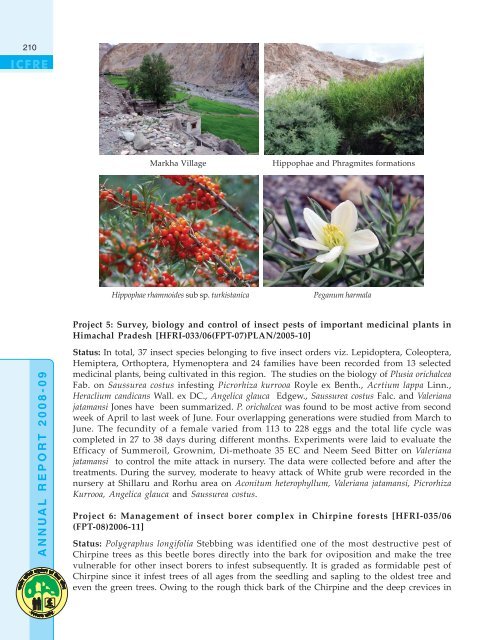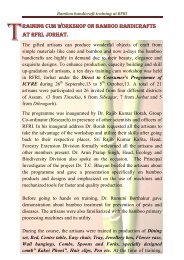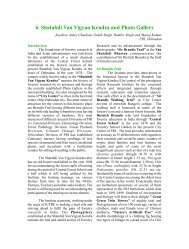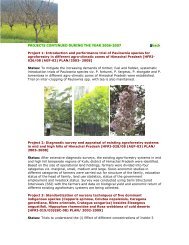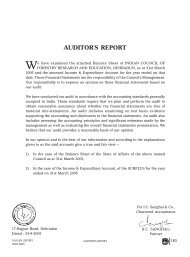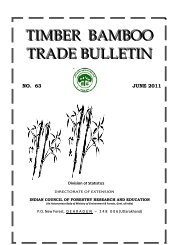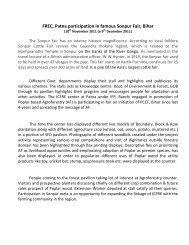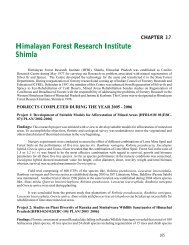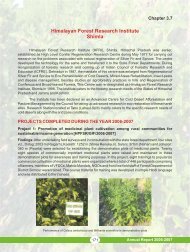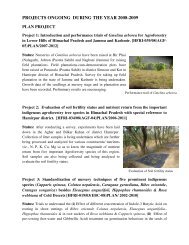Himalayan Forest Research Institute, Shimla - ICFRE
Himalayan Forest Research Institute, Shimla - ICFRE
Himalayan Forest Research Institute, Shimla - ICFRE
You also want an ePaper? Increase the reach of your titles
YUMPU automatically turns print PDFs into web optimized ePapers that Google loves.
210<br />
<strong>ICFRE</strong><br />
ANNUAL REPORT 2008-09<br />
Markha Village Hippophae and Phragmites formations<br />
Hippophae rhamnoides sub sp. turkistanica Peganum harmala<br />
Project 5: Survey, biology and control of insect pests of important medicinal plants in<br />
Himachal Pradesh [HFRI-033/06(FPT-07)PLAN/2005-10]<br />
Status: In total, 37 insect species belonging to five insect orders viz. Lepidoptera, Coleoptera,<br />
Hemiptera, Orthoptera, Hymenoptera and 24 families have been recorded from 13 selected<br />
medicinal plants, being cultivated in this region. The studies on the biology of Plusia orichalcea<br />
Fab. on Saussurea costus infesting Picrorhiza kurrooa Royle ex Benth., Acrtium lappa Linn.,<br />
Heraclium candicans Wall. ex DC., Angelica glauca Edgew., Saussurea costus Falc. and Valeriana<br />
jatamansi Jones have been summarized. P. orichalcea was found to be most active from second<br />
week of April to last week of June. Four overlapping generations were studied from March to<br />
June. The fecundity of a female varied from 113 to 228 eggs and the total life cycle was<br />
completed in 27 to 38 days during different months. Experiments were laid to evaluate the<br />
Efficacy of Summeroil, Grownim, Di-methoate 35 EC and Neem Seed Bitter on Valeriana<br />
jatamansi to control the mite attack in nursery. The data were collected before and after the<br />
treatments. During the survey, moderate to heavy attack of White grub were recorded in the<br />
nursery at Shillaru and Rorhu area on Aconitum heterophyllum, Valeriana jatamansi, Picrorhiza<br />
Kurrooa, Angelica glauca and Saussurea costus.<br />
Project 6: Management of insect borer complex in Chirpine forests [HFRI-035/06<br />
(FPT-08)2006-11]<br />
Status: Polygraphus longifolia Stebbing was identified one of the most destructive pest of<br />
Chirpine trees as this beetle bores directly into the bark for oviposition and make the tree<br />
vulnerable for other insect borers to infest subsequently. It is graded as formidable pest of<br />
Chirpine since it infest trees of all ages from the seedling and sapling to the oldest tree and<br />
even the green trees. Owing to the rough thick bark of the Chirpine and the deep crevices in


